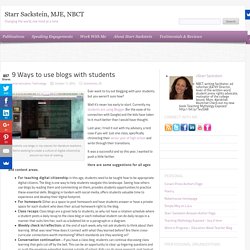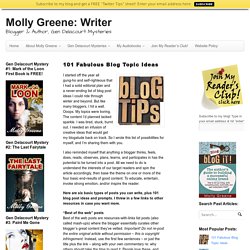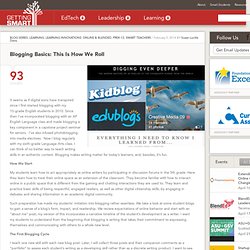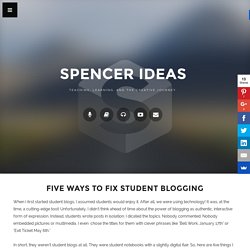

19 Ways to use blogs with students. Students use blogs in my classes for literature reactions.

We’re working to create a culture of digital citizenship around our love of reading. Ever want to try out blogging with your students, but you weren’t sure how? Well it’s never too early to start. Currently my students are using Blogger (for the ease of its connection with Google) and the kids have taken to it much better than I would have thought. Last year, I tried it out with my advisory, a test case if you will. It was a successful and so this year, I wanted to push a little farther. Here are some suggestions for all ages and content areas. For teaching digital citizenship: in this age, students need to be taught how to be appropriate digital citizens.
How do you use blogs with your students?
101 Fabulous Blog Topic Ideas. I started off the year all gung-ho and self-righteous that I had a solid editorial plan and a never-ending list of blog post ideas I could ride through winter and beyond.

But like many bloggers, I hit a wall. Ooops. My topics were boring. The content I’d planned lacked sparkle. I was tired, stuck, burnt out. I also reminded myself that anything a blogger thinks, feels, does, reads, observes, plans, learns, and participates in has the potential to be turned into a post. Here are six basic types of posts you can write, plus 101 blog post ideas and prompts. “Best of the web” posts Best of the web posts are resources-with-links list posts (also called mash-ups) where the blogger essentially curates other blogger’s great content they’ve vetted.
Ideas for “Best of” posts:1. Essays – personal Everything you think, remember, feel, or do is fair game – as long as your treatment of it entertains, inspires, or generates a positive emotion in your reader. Blogging Basics. It seems as if digital eons have transpired since I first started blogging with my 10-grade English students in 2010.

Since then I’ve incorporated blogging with an AP English Language class and made blogging a key component in a capstone project seminar for seniors. I’ve also infused photoblogging into media electives. Now I blog regularly with my sixth-grade Language Arts class. I can think of no better way to teach writing skills in an authentic context. Blogging makes writing matter for today’s learners; and, besides, it’s fun. How We Start My students learn how to act appropriately as online writers by participating in discussion forums in the 5th grade. Such preparation has made my students’ initiation into blogging rather seamless. The First Blogging Cycle I teach one new skill with each new blog post. Post 1: How to Post The initial “about me” post allows students to become familiar with the blogging format and application.
Post 2: Ownership and Tagging Post 3: Linking and Connecting. Blogi ekirjaksi. Writing prompts. Fix-It in Five. When I first started student blogs, I assumed students would enjoy it.

After all, we were using technology! It was, at the time, a cutting-edge tool! Unfortunately, I didn’t think ahead of time about the power of blogging as authentic, interactive form of expression. Instead, students wrote posts in isolation. I dicated the topics. In short, they weren’t student blogs at all. Student autonomy.
Looking for More? If you enjoyed this post, check out this free resource Student Blogging: Rubric, Self-Assessment, and Checklist If you want to see more posts about student blogging and digital writing, check out this page for other posts and resources.If you enjoy this blog, please subscribe via email and receive each post in your inbox, along with one free resource a week.If you're interested in workshops or sessions on digital writing and student blogging, I'm available to consult with schools, districts and organizations. TiPin penaali. WP-opas. BlogBooker - Blog Book.
Blogger Secrets. We all know good writing when we see it and we cringe when we see terrible writing.

The worst thing is that the harder people try to write well, the worse their writing usually becomes. Here are 10 secrets of professional writers are guaranteed to improve your writing. 1. Avoid clichés But you know that, don’t you? Here are some examples that I have found in recent blogs: In this day and ageNever a dull momentGiven the green lightRose to great heightsCalm before the storm The problem, and the attraction, with clichés is that they seem to say exactly what we want to say, so it is tempting to hang on to these tried and true expressions. And yet, they will deaden your prose, make readers mentally sign off and expose you as an amateur. So avoid overused sayings (yes, I know, like the plague). 2. Use a conversational tone. Think of it this way; if you wouldn’t say it a casual conversation, think twice before you write it.